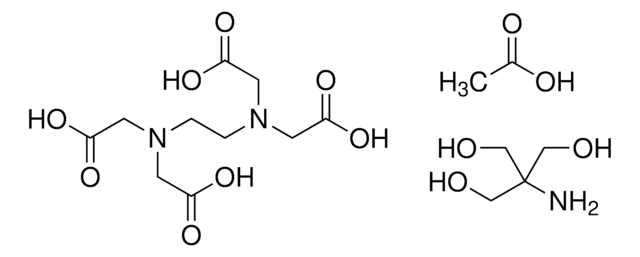93337
Trizma® acetate
BioUltra, ≥99.0% (NT)
Sinónimos:
TRIS acetate salt, Tris(hydroxymethyl)aminomethane acetate salt
About This Item
Productos recomendados
product line
BioUltra
Quality Level
assay
≥99.0% (NT)
form
crystalline powder
impurities
insoluble matter, passes filter test
ign. residue
≤0.2%
loss
≤0.2% loss on drying, 20 °C (HV)
pH
6.0-7.0 (25 °C, 0.5 M in H2O)
solubility
H2O: 0.5 M at 20 °C, clear, colorless
anion traces
chloride (Cl-): ≤50 mg/kg
sulfate (SO42-): ≤50 mg/kg
cation traces
Al: ≤5 mg/kg
As: ≤0.1 mg/kg
Ba: ≤5 mg/kg
Bi: ≤5 mg/kg
Ca: ≤10 mg/kg
Cd: ≤5 mg/kg
Co: ≤5 mg/kg
Cr: ≤5 mg/kg
Cu: ≤5 mg/kg
Fe: ≤5 mg/kg
K: ≤50 mg/kg
Li: ≤5 mg/kg
Mg: ≤5 mg/kg
Mn: ≤5 mg/kg
Mo: ≤5 mg/kg
Na: ≤50 mg/kg
Ni: ≤5 mg/kg
Pb: ≤5 mg/kg
Sr: ≤5 mg/kg
Zn: ≤5 mg/kg
λ
0.5 M in H2O
UV absorption
λ: 260 nm Amax: 0.07
λ: 280 nm Amax: 0.05
SMILES string
CC(O)=O.NC(CO)(CO)CO
InChI
1S/C4H11NO3.C2H4O2/c5-4(1-6,2-7)3-8;1-2(3)4/h6-8H,1-3,5H2;1H3,(H,3,4)
InChI key
PIEPQKCYPFFYMG-UHFFFAOYSA-N
¿Está buscando productos similares? Visita Guía de comparación de productos
Application
Other Notes
Legal Information
Storage Class
11 - Combustible Solids
wgk_germany
WGK 3
flash_point_f
Not applicable
flash_point_c
Not applicable
ppe
Eyeshields, Gloves, type N95 (US)
Certificados de análisis (COA)
Busque Certificados de análisis (COA) introduciendo el número de lote del producto. Los números de lote se encuentran en la etiqueta del producto después de las palabras «Lot» o «Batch»
¿Ya tiene este producto?
Encuentre la documentación para los productos que ha comprado recientemente en la Biblioteca de documentos.
Los clientes también vieron
Nuestro equipo de científicos tiene experiencia en todas las áreas de investigación: Ciencias de la vida, Ciencia de los materiales, Síntesis química, Cromatografía, Analítica y muchas otras.
Póngase en contacto con el Servicio técnico










